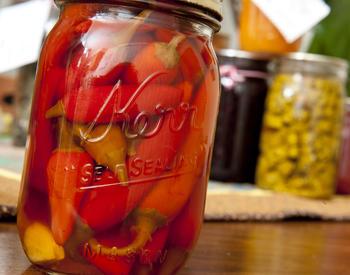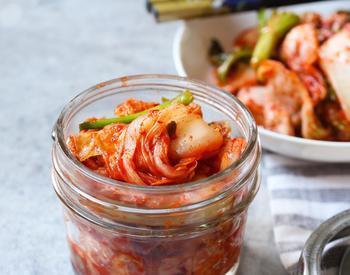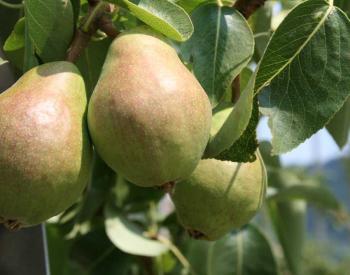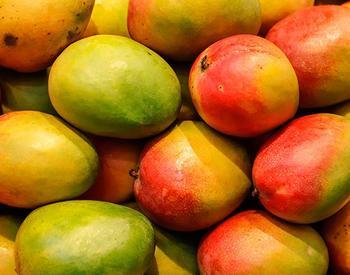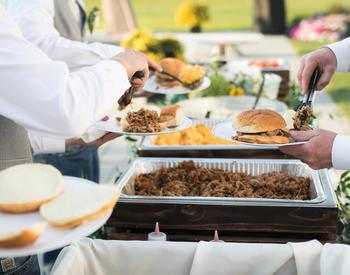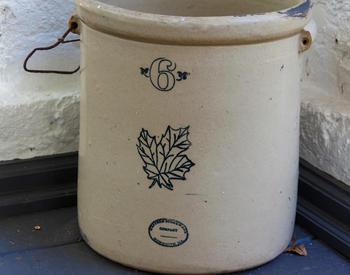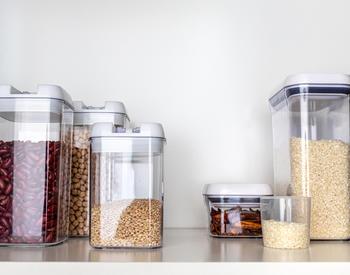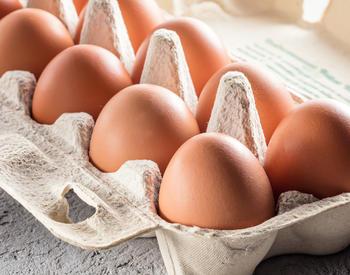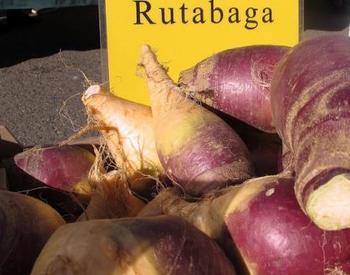Download this publication as a PDF
Four basic pickle products
Brined or fermented pickles
These may take three weeks or longer to cure. Small batch ferments, such as a single quart jar, will ferment more quickly. Cucumbers change from a bright green to an olive or yellow green. The interior becomes uniformly translucent.
Salt is added at the beginning of the process to interfere with the growth of microorganisms other than the lactic acid bacteria. A small amount of vinegar may be called for to create an acid environment that discourages growth of unwanted microorganisms. The salt in the original brine is quite concentrated and draws liquid out of the cucumbers. The liquid drawn from the cucumbers contains carbohydrates that serve as food for the bacteria.
As the lactic acid bacteria multiply, they produce lactic acid that makes brine even more acidic. This acid reacts with the chlorophyll of the cucumbers causing it to become an olive‑green.
A scum can form on the surface of the brine if it is exposed to air as yeast and mold grow. It is important to keep their population down by removing the scum daily.
Fresh pack or quick process
These are made by combining ingredients (with or without heating) and are processed in a boiling water canner right away. As a rule of thumb, recipes should call for at least as much vinegar (5% acid) as water. Use only reliable up‑to‑date recipes and follow them carefully. Do not alter vinegar, food, or water proportions.
Fruit pickles
These are made of whole fruits simmered in a spicy, sweet‑sour syrup.
Relishes
These are made from chopped fruits or vegetables with seasonings.
Utensils
Do not use zinc, copper, brass, galvanized metal, or iron utensils. These metals may react with acids or salts and cause undesirable color changes in the pickles or form undesirable compounds.
Ingredients make a difference
Vegetables or Fruits
- Select tender vegetables and firm fruits that are free from blemishes.
- For best results, use cucumbers within 24 hours of picking. Use a variety of cucumbers grown especially for pickling. Good quality pickles are not made from immature “slicing” cucumbers.
- Use light skinned cucumbers that are attractively warted, not more than 2 inches in diameter and young enough so the seeds have not matured.
- Commercially waxed cucumbers should not be used for fermented pickles or whole pickles. Pickling liquid cannot penetrate into the waxed cucumbers.
- Wash all vegetables and fruits thoroughly in cold water. Do not use if moldy.
- Remove blossom ends of cucumbers. They may contain enzymes, which cause softening in pickles.
Salt
Recommended
- Pickling and canning salt are pure, granulated salts containing no anti‑caking agents, and no iodine. Do not alter salt concentration in fermented pickles or sauerkraut. Proper fermentation depends on correct proportions of salt and other ingredients.
- Non-iodized table salt can be used. It may cause a cloudy brine, but this does not harm the pickles.
Not Recommended
- Ice cream salt or rock salt might contain unsafe impurities are not recommended.
- Sea salt, Mediterranean salt, Himalayan pink salt – these gourmet salts contain minerals that may cause pickle discoloration or off-flavors. Their crystal size measures differently and they may not dissolve fully in brine.
- Sour salt is a small tablet containing citric acid and salt that is used in the commercial canning of seafood. At retail level, it is marketed as a water softener. The salt in the tablet removes ions of calcium and magnesium, while the citric acid renders the iron in the water unavailable. This type of salt, due to its tablet form and mixture, is not suitable for pickling purposes.
- Salt substitutes (such as potassium chloride) cannot be used to make satisfactory pickle products. The pickles will be crisp and crunchy, but will not have the characteristic salty pickled taste. Potassium has a bitter taste and the pickles generally taste terrible. See Low-salt pickles. Salt substitutes should not be used when making fermented pickles.
- Flaked salt varies in density, so is not recommended for use in pickled and fermented foods. If used, measure by weight NOT measuring spoons or cups – 1 cup of granulated salt weighs 10.2 ounces (289 grams).
- Kosher salt, a coarser salt, is not recommended unless recipe calls for it. If used, measure by weight NOT measuring spoons or cups – 1 cup of granulated salt weighs 10.2 ounces (289 grams).
Vinegar
- Use vinegar with 5% acidity.
- White distilled vinegar has a sharp pungent acid taste and is desirable when light color is important such as pickled onions, cauliflowers and fruits.
- Cider vinegar has a milder flavor but may discolor some pickle products.
- Do not use homemade vinegar or brands with an unknown acidity. The percent acidity must be known for successful pickling.
- If a less sour product is desired, add sugar to the pickling solution rather than reducing the amount of vinegar. Vinegar is important for safety reasons.
Spices
- Use whole spices. Powdered spices may cause the product to darken and become cloudy.
- Use fresh spices. Last year’s supply will have lost much flavor.
- Pick dill as soon as the flowers begin to open.
- Dill seed can be substituted for fresh dill but may not have as good flavor. (3 dill heads = 1 Tablespoon seeds = 1 ‑ 3 drops dill oil).
Tip: Pick dill at its prime maturity and freeze until ready to make pickles. Freeze dill in sturdy plastic or glass containers so not to flavor food in freezer.
Garlic
- Use fresh, mature garlic. Immature or old garlic sometimes turns pink or blue as anthocyanins (coloring pigment) react to acid.
Water
- Moderately soft water makes the best brine for pickles. Hard water may cause cloudiness and iron and sulfur may cause off‑colors.
- If only hard water is available, boil and let sit for 24 hours and skim off scum. Water should be used from the top of the container without disturbing any sediment on the bottom.
Sugar
- Either white or brown may be used.
- Brown sugar may give a darker color to the brine.
- Corn syrup and honey may be too strong flavored.
Sugar substitutes – if you plan to use a sugar statute, follow the recipe developed for these products. Heat and storage may cause bitterness and flavor changes. They do not add the firmness to pickles that sugar imparts.
Firming agents
- Alum may be safely used to firm fermented cucumbers. However, it is not necessary and is not included in most up‑to‑date recipes.
- Lime, which is calcium hydroxide, is sometimes called for in pickling. If lime is used to help firm pickles, it should be food grade.
- Packages are labeled “Pickling lime,” where canning supplies are sold. Other versions of this product, known as slake lime, lime hydrate or hydrated lime are not manufactured for use in foods.
- Soaking fresh cucumber slices in a lime‑water solution for 12‑24 hours before pickling improves firmness. Excess lime absorbed by the cucumbers must be removed to make safe pickles. Drain, rinse, and then re-soak cucumbers in fresh water for 1 hour. Repeat the rinsing and soaking steps two more times.
- Another option to help keep quick pickles crisp is a calcium chloride product (Pickle Crisp®). The granules are added to the filled jars of pickles before applying the lids. Follow the manufacturer’s instructions on the container.
- Grape leaves – some old fashioned recipes call for grape leaves. These leaves contain tannins that can inhibit enzymes that soften pickles.
Processing pickles
Both microorganisms and enzymes can cause spoilage of pickled products. Processing will prevent these problems. Follow recommended methods for traditional boiling water canner processing or low temperature pasteurization.
Note: Low-temperature pasteurization is only recommended for cucumber pickles – not reduced sodium or other vegetable pickles. Do not process fermented pickles before they develop an acidic taste.
Storing pickles
- Cool Extreme fluctuation of temperature can cause a breakdown of the texture. Pickles stored at warm temperatures could start fermenting again and cause the jars to break.
- Dark Light often causes products to fade and become less appetizing. This does not necessarily produce spoilage.
- Dry Continuous moisture may cause closures to rust and eventually produce spoilage.
Remove jar rings. If liquid is lost during processing and rings are not removed, it will cause corrosion and the rings will be hard to remove. This is especially true for pickles due to their high acid and salt content.
After opening: Store pickles in the refrigerator with the pickling liquid covering the fruits or vegetables.
Source: OSU Master Food Preserver Program
Trade-name products and services are mentioned as illustrations only. This does not mean that the Oregon State University Extension Service either endorses these products and services or intends to discriminate against products and services not mentioned.
